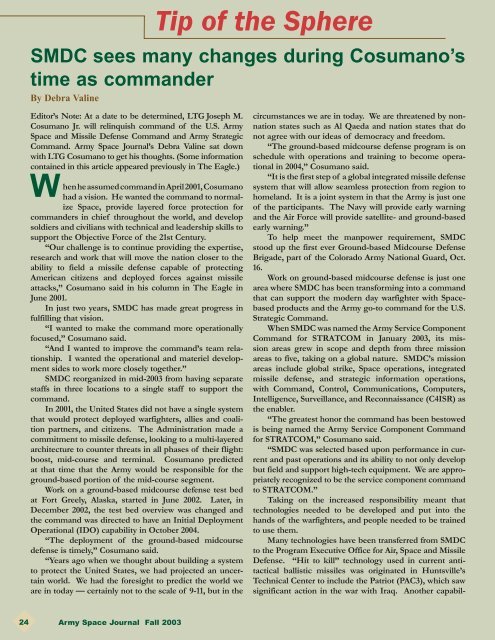Volume 2, Number 4 - Space and Missile Defense Command - U.S. ...
Volume 2, Number 4 - Space and Missile Defense Command - U.S. ...
Volume 2, Number 4 - Space and Missile Defense Command - U.S. ...
You also want an ePaper? Increase the reach of your titles
YUMPU automatically turns print PDFs into web optimized ePapers that Google loves.
Tip of the Sphere<br />
SMDC sees many changes during Cosumano’s<br />
time as comm<strong>and</strong>er<br />
By Debra Valine<br />
Editor’s Note: At a date to be determined, LTG Joseph M.<br />
Cosumano Jr. will relinquish comm<strong>and</strong> of the U.S. Army<br />
<strong>Space</strong> <strong>and</strong> <strong>Missile</strong> <strong>Defense</strong> Comm<strong>and</strong> <strong>and</strong> Army Strategic<br />
Comm<strong>and</strong>. Army <strong>Space</strong> Journal’s Debra Valine sat down<br />
with LTG Cosumano to get his thoughts. (Some information<br />
contained in this article appeared previously in The Eagle.)<br />
W<br />
hen he assumed comm<strong>and</strong> in April 2001, Cosumano<br />
had a vision. He wanted the comm<strong>and</strong> to normalize<br />
<strong>Space</strong>, provide layered force protection for<br />
comm<strong>and</strong>ers in chief throughout the world, <strong>and</strong> develop<br />
soldiers <strong>and</strong> civilians with technical <strong>and</strong> leadership skills to<br />
support the Objective Force of the 21st Century.<br />
“Our challenge is to continue providing the expertise,<br />
research <strong>and</strong> work that will move the nation closer to the<br />
ability to field a missile defense capable of protecting<br />
American citizens <strong>and</strong> deployed forces against missile<br />
attacks,” Cosumano said in his column in The Eagle in<br />
June 2001.<br />
In just two years, SMDC has made great progress in<br />
fulfilling that vision.<br />
“I wanted to make the comm<strong>and</strong> more operationally<br />
focused,” Cosumano said.<br />
“And I wanted to improve the comm<strong>and</strong>’s team relationship.<br />
I wanted the operational <strong>and</strong> materiel development<br />
sides to work more closely together.”<br />
SMDC reorganized in mid-2003 from having separate<br />
staffs in three locations to a single staff to support the<br />
comm<strong>and</strong>.<br />
In 2001, the United States did not have a single system<br />
that would protect deployed warfighters, allies <strong>and</strong> coalition<br />
partners, <strong>and</strong> citizens. The Administration made a<br />
commitment to missile defense, looking to a multi-layered<br />
architecture to counter threats in all phases of their flight:<br />
boost, mid-course <strong>and</strong> terminal. Cosumano predicted<br />
at that time that the Army would be responsible for the<br />
ground-based portion of the mid-course segment.<br />
Work on a ground-based midcourse defense test bed<br />
at Fort Greely, Alaska, started in June 2002. Later, in<br />
December 2002, the test bed overview was changed <strong>and</strong><br />
the comm<strong>and</strong> was directed to have an Initial Deployment<br />
Operational (IDO) capability in October 2004.<br />
“The deployment of the ground-based midcourse<br />
defense is timely,” Cosumano said.<br />
“Years ago when we thought about building a system<br />
to protect the United States, we had projected an uncertain<br />
world. We had the foresight to predict the world we<br />
are in today — certainly not to the scale of 9-11, but in the<br />
circumstances we are in today. We are threatened by nonnation<br />
states such as Al Qaeda <strong>and</strong> nation states that do<br />
not agree with our ideas of democracy <strong>and</strong> freedom.<br />
“The ground-based midcourse defense program is on<br />
schedule with operations <strong>and</strong> training to become operational<br />
in 2004,” Cosumano said.<br />
“It is the first step of a global integrated missile defense<br />
system that will allow seamless protection from region to<br />
homel<strong>and</strong>. It is a joint system in that the Army is just one<br />
of the participants. The Navy will provide early warning<br />
<strong>and</strong> the Air Force will provide satellite- <strong>and</strong> ground-based<br />
early warning.”<br />
To help meet the manpower requirement, SMDC<br />
stood up the first ever Ground-based Midcourse <strong>Defense</strong><br />
Brigade, part of the Colorado Army National Guard, Oct.<br />
16.<br />
Work on ground-based midcourse defense is just one<br />
area where SMDC has been transforming into a comm<strong>and</strong><br />
that can support the modern day warfighter with <strong>Space</strong>based<br />
products <strong>and</strong> the Army go-to comm<strong>and</strong> for the U.S.<br />
Strategic Comm<strong>and</strong>.<br />
When SMDC was named the Army Service Component<br />
Comm<strong>and</strong> for STRATCOM in January 2003, its mission<br />
areas grew in scope <strong>and</strong> depth from three mission<br />
areas to five, taking on a global nature. SMDC’s mission<br />
areas include global strike, <strong>Space</strong> operations, integrated<br />
missile defense, <strong>and</strong> strategic information operations,<br />
with Comm<strong>and</strong>, Control, Communications, Computers,<br />
Intelligence, Surveillance, <strong>and</strong> Reconnaissance (C4ISR) as<br />
the enabler.<br />
“The greatest honor the comm<strong>and</strong> has been bestowed<br />
is being named the Army Service Component Comm<strong>and</strong><br />
for STRATCOM,” Cosumano said.<br />
“SMDC was selected based upon performance in current<br />
<strong>and</strong> past operations <strong>and</strong> its ability to not only develop<br />
but field <strong>and</strong> support high-tech equipment. We are appropriately<br />
recognized to be the service component comm<strong>and</strong><br />
to STRATCOM.”<br />
Taking on the increased responsibility meant that<br />
technologies needed to be developed <strong>and</strong> put into the<br />
h<strong>and</strong>s of the warfighters, <strong>and</strong> people needed to be trained<br />
to use them.<br />
Many technologies have been transferred from SMDC<br />
to the Program Executive Office for Air, <strong>Space</strong> <strong>and</strong> <strong>Missile</strong><br />
<strong>Defense</strong>. “Hit to kill” technology used in current antitactical<br />
ballistic missiles was originated in Huntsville’s<br />
Technical Center to include the Patriot (PAC3), which saw<br />
significant action in the war with Iraq. Another capabil-<br />
24<br />
Army <strong>Space</strong> Journal Fall 2003

















